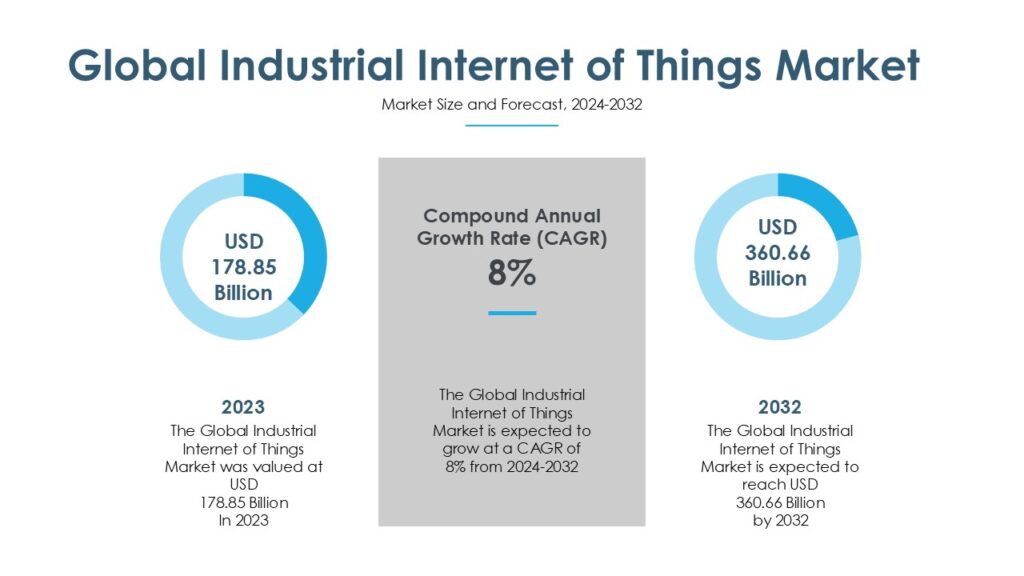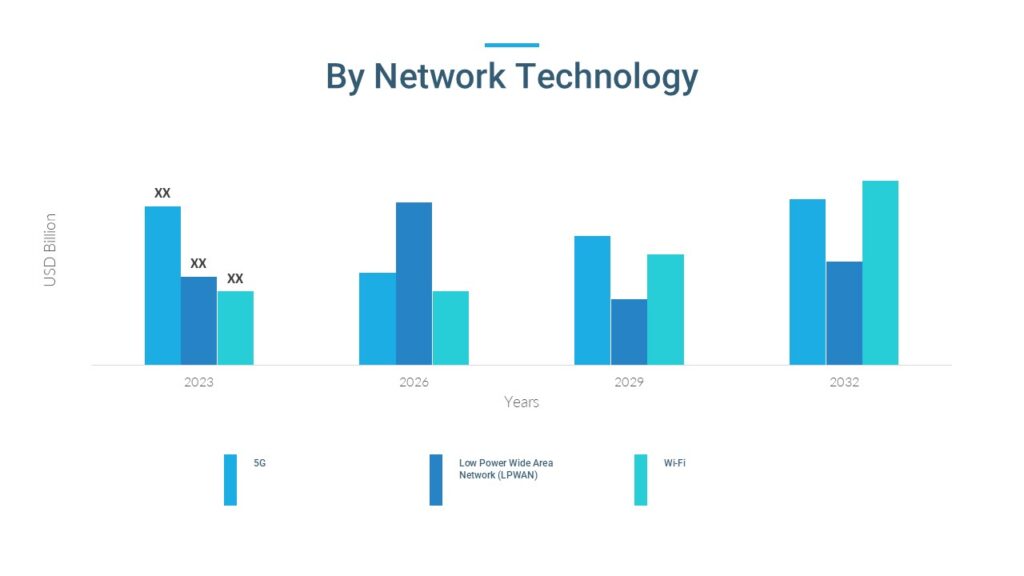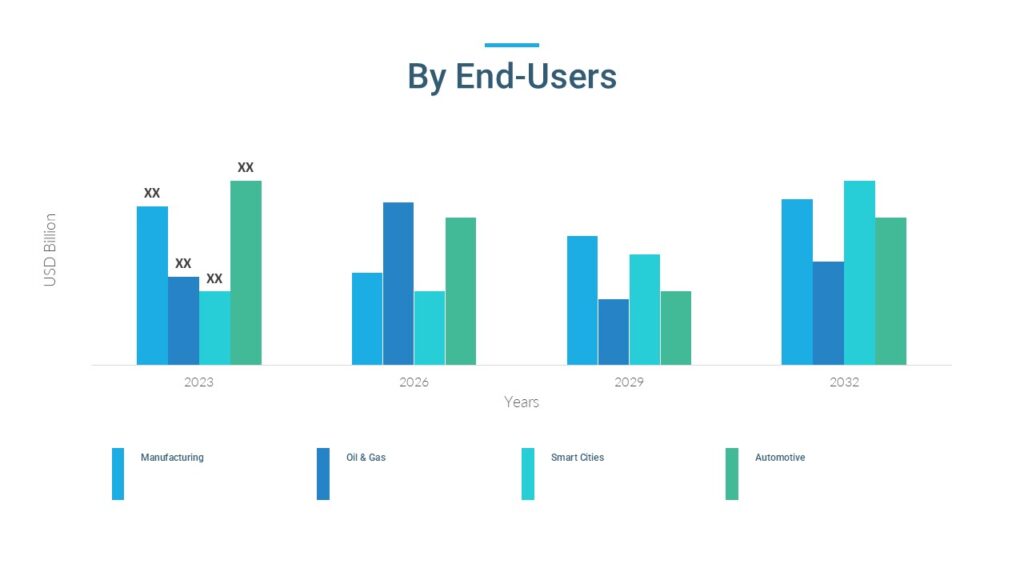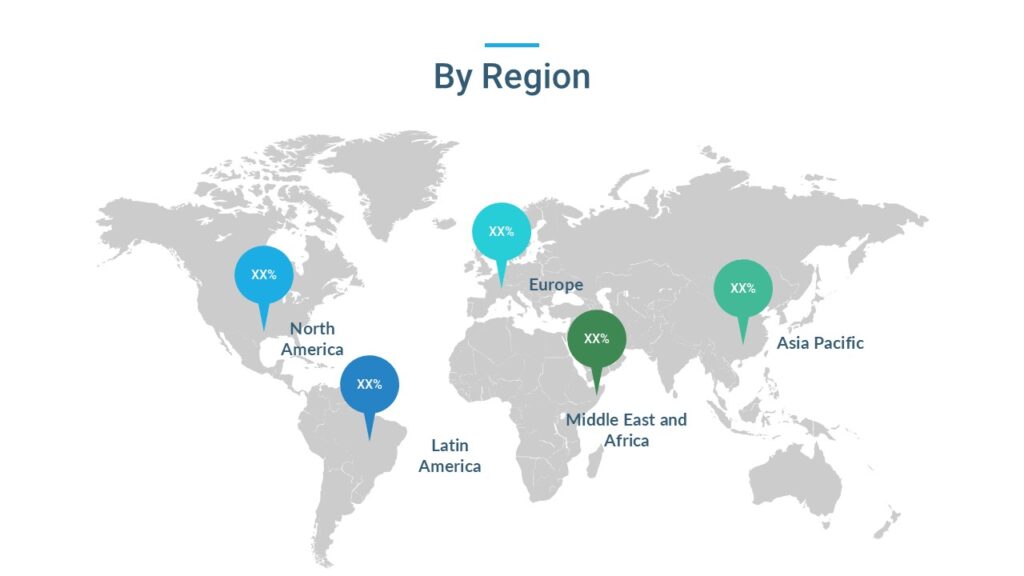
Global Industrial Internet of Things Market "(By Component: Hardware, Software, Services; By Network Technology: 5G, Low Power Wide Area Network (LPWAN), Wi-Fi; By End-Use Industry: Manufacturing, Oil & Gas, Automotive, Smart Cities; By Application: Manufacturing, Energy & Utilities, Transportation & Logistics, Agriculture; By Region: North America, Europe, Asia Pacific, Latin America, and Middle East and Africa)”- Global Industry Analysis, Size, Share, Growth, Trends, And Forecast, 2024-2032
- Category: ICT, Automation and Semiconductor
- Report ID: CMR33901
- Published Date:
A prominent research firm, Cognizance Market Research added a cutting-edge industry report on the “Global Industrial Internet of Things Market”. The report studies the current and past growth trends and opportunities for the market to gain valuable insights during the forecast period from 2023 to 2032.
Global Industrial Internet of Things Market Analysis:
According to cognizance market research, the global industrial Internet of Things market was valued at US$ 178.85 Billion in 2023 and is anticipated to reach US$ 360.66 Billion by the end of 2032 with a CAGR of 8% from 2023 to 2032.

What is the Global Industrial Internet of Things Market?
The Global Industrial Internet of Things (IIoT) market can also be referred to as the act of adopting IoT technologies in industrial processes such that devices, machines, sensors, and systems are connected, communicate, and share information. It creates a network of networked devices for firms providing an operation supervisory by which business processes can be observed, understood, and improved in real-time across several industries inclusive of manufacturing, energy, agriculture, transportation, and healthcare.
The Industrial IoT market incorporates smart technologies including, artificial intelligence (AI), machine learning (ML), cloud computing, and big data to support decision-making processes, to increase accuracy in the prognosis of schedule breakdowns, to decrease the degree of time loss, and to optimize resource management. It helps organizations implement automation and data solution that optimizes business processes, efficiency, and a safe working environment as well as lower operating expenses.
As Industry 4.0 is established, the global IIoT market is expanding as industries look for better ways to manage their processes. This is because of the escalating rate of industrialization, changing technology requirements as well as the need to streamline operational visibilities. Further, the subsequent availability of 5G networks and the general adoption of the edge computing concept are also contributing to the growth of the market more quickly; allowing businesses to engage in real-time data processing and communication at an even faster rate.
Global Industrial Internet of Things Market Outlook:
Now, the opportunities for the Global Industrial Internet of Things (IIoT) market are expected to ascend in the coming years as the concept of digitalization and automation proliferates industries. They are adopting IIoT solutions as they seek to increase their productivity, save costs, and improve their decision-making, especially in those industries of manufacturing, energy, and logistics.
This is important to the growth of the market with the introduction of the 5G technology into the market. This will make it easier and faster to transmit data thus making IIoT devices work efficiently, in real-time mode. Further, edge computing is projected to offer data processing discretely, relieving pressure on cloud computing services and improving the system’s performance.
Manufacturing is the leading IIoT industry segment, which, for the most part, involves smart production and automation. The larger applications of IIoT are used in Predictive Maintenance/Preventive Maintenance, Quality Analysis, Supply Chain Management, etc where businesses can enhance productivity and efficiencies and hence cut down on expenses to the minimum.
Energy and utilities are also using IIoT to enhance their energy and grid efficiency interfaces. Through collecting real-time data from sensors and devices IIoT also contributes to the energy distribution and supports the change to renewable sources.
As for the IIoT, its application is particularly promising in healthcare in connection with the constant growth of the role of remote patient monitoring and connected medical devices. They bring real-time health data to be accumulated hence enhancing the treatment of patients besides eradicating redundant processes in healthcare facilities.
North America retains its position as a dominant market for the IIoT, yet the Asia-Pacific region is expected to be the quickest developing one due to the industrialization process and governmental programs. It would be essential to observe that the trend towards automation in industries of countries such as China and India will propel IIoT advancement in various industries further.
Segment Analysis:
The global Industrial Internet of Things (IIoT) market is categorized based on components such as hardware, software, and services. Hardware can be what is usually known as the Internet of Things, things such as sensors, connectivity modules, and others while software would be data management platforms, analytics tools, and more. Services offer advisory and support for service inclusion and maintenance of efficient IIoT implementation and functioning.


About application type, the IIoT market is broadly applied in various industries such as manufacturing, energy and utilities, transportation, and healthcare industries. Manufacturing takes the lion’s share as the industry most actively uses IIoT for process management, prediction, and conversion to smart factories. Manufacturing applies IIoT for asset optimization, energy for smart grid and renewable energy management, and Transport for smart logistics and fleet management. Healthcare applications are related to the system to monitor the patient and control healthcare applications. Region North America and Europe remain on the top but regions like Asia Pacific are now considered as high growth regions due to increasing industrialization and adoption of internet-connected gadgets.


Geographical Analysis:
North America is the largest consumer of the IIoT market because of the technological development and the strong industrial sector in this region. Among the regions, it dominates the global IIoT market, mainly due to the manufacturing, energy, and technology industries. Further growth will be driven by high investment in smart factory solutions, automation, and the increasing popularity of the 5G network in this region. Moreover, the US government’s emphasis on smart infrastructures and the growing need for smart energy systems are the major drivers behind the success of IIoT in North America.
In Europe, the market for IIoT is, however, well-developed and the leaders are Germany, the United Kingdom, and France. Especially industries like automotive, manufacturing, and energy, incline towards IIoT across the geographical region. EUAP programs encouraging digital evolution and climate change, including Industry 4.0 and smart distribution systems are instrumental in IoT solution development. The market is also growing due to the rising cross-border partnership and investment in new technologies in the region.

Currently, the Asia-Pacific region has the fastest-growing IIoT market because of investments from China, Japan, and India in automation. Some of the key motives that are seen behind Industrial IoT integration include China’s manufacturing industry going gaga over IIoT to improve productivity levels and Japan with its Robotics and Automation seeking to advance IIoT integration. India’s large base of manufacturing industries is beginning to turn to digital technologies to improve efficiency. Increased industrialization in the region, government support, persevering necessity of smart connectivity in manufacturing and energy industries are anticipated to bolster the IIoT market by leaps and bounds in the forecasted period.
The market size of the Industrial Internet of Things Market in terms of re venue is forecast for the years 2020-2032 where the base year is considered as 2020, while 2020 to 2022 is considered as historical years and 2024 to 2032 as the forecast period. The global market for the Industrial Internet of Things also offers a compound annual growth rate (CAGR) for the forecast period in the given market report. This integrated Global Industrial Internet of Things Market report helps to improve the understanding of novel and emerging trends affecting companies and businesses on a local and international scale. The Global Industrial Internet of Things Market size report includes the revenue generation of the Global Industrial Internet of Things Market from several segments depending on their performance and provides a detailed analysis of the factors that act as the drivers, trends, restraints, and opportunities that are responsible for revenue generation of the Global Industrial Internet of Things Market.
The study has been made after secondary as well as primary research has been conducted. Other sources for secondary research were Internet sources and numerical data obtained from government bodies, trade associations, websites, etc. Many researchers have also used the combination of bottom-up and top-down approaches to investigate various factors in the Global Industrial Internet of Things Market. As part of secondary research, various original players’ product portfolios were examined in detail. Besides, articles and journals, press releases, annual reports, white papers, and other documents related to the Global Industrial Internet of Things Market have also been reviewed. One of the most used research techniques, known as primary research, required most of the research work; industry gurus were engaged in conducting telephonic and questioner-based interviews.
The report provides an introduction, a briefing on the findings and limitations, as well as a growth pattern of various segments covered in the study. A detailed Y-o-Y analysis with profound market insights has been sprinkled in this report to decode the Y-o-Y aspect in the Global Industrial Internet of Things Market. Furthermore, this report is centered on changing competitive position in the global market. All the aforesaid indices act as beneficial tools for the current stakeholders and market players apart from the companies, which are planning to venture into the Global Industrial Internet of Things Market. The next part of the Global Industrial Internet of Things Market report focuses on the USP’s of the Industry which include the key developments; New products launched, Research collaboration Agreement, acquisition, etc., Technology monitoring, Pipeline analysis, Disease/Prevalence analysis, and Regulatory scenario.
Global Industrial Internet of Things Market Competitive Landscape:
There are several small and major firms participating in the highly fragmented Global Industrial Internet of Things Market. The new strategies formed by companies revolve around accuracy and precision. The following are some of the major market participants:
- Siemens AG
- General Electric
- Cisco System Inc.
- Honeywell International Inc.
- IBM Corporation
- Intel Corporation
- Microsoft Corporation
- Bosch Group
- Rockwell Automation
- SAP SE
- Emerson Electric CO. Ltd
- Huawei Technologies Ltd
The report explores the competitive scenario of the Global Industrial Internet of Things Market. Major players working in the Global Industrial Internet of Things Market have been named and profiled for unique commercial attributes. Company overview (company description, product portfolio, geographic presence, employee strength, Key management, etc.), financials, SWOT analysis, recent developments, and key strategies are some of the features of companies profiled in the Global Industrial Internet of Things Market report.
Segmentation:
Global Industrial Internet of Things Market, By Component:
- Software
- Hardware
- Services
Global Industrial Internet of Things Market, By Network Technology:
- 5G
- Low Power Wide Area Network (LPWAN)
- Wi-Fi
Global Industrial Internet of Things Market, By End-use Industry:
- Manufacturing
- Oil & Gas
- Automotive
- Smart Cities
Global Industrial Internet of Things Market, By Application:
- Manufacturing
- Energy & Utilities
- Transportation and Logistic
- Agriculture
- Healthcare
Global Industrial Internet of Things Market, by Region:
- North America
- U.S.
- Canada
- Europe
- Germany
- U.K.
- France
- Spain
- Italy
- Rest of Europe
- Asia Pacific
- Japan
- China
- India
- Australia & New Zealand
- South Korea
- Rest of Asia Pacific
- Latin America
- Brazil
- Mexico
- Rest of Latin America
- Middle East & Africa
- GCC
- South Africa
- Rest of the Middle East & Africa
Research Methodology: Aspects
Market research is a crucial tool for organizations aiming to navigate the dynamic landscape of customer preferences, business trends, and competitive landscapes. At Cognizance Market Research, acknowledging the importance of robust research methodologies is vital to delivering actionable insights to our clientele. The significance of such methodologies lies in their capability to offer clarity in complexity, guiding strategic management with realistic evidence rather than speculation. Our clientele seek insights that excel superficial observations, reaching deep into the details of consumer behaviours, market dynamics, and evolving opportunities. These insights serve as the basis upon which businesses craft tailored approaches, optimize product offerings, and gain a competitive edge in an ever-growing marketplace.
The frequency of information updates is a cornerstone of our commitment to providing timely, relevant, and accurate insights. Cognizance Market Research adheres to a rigorous schedule of data collection, analysis, and distribution to ensure that our reports reflect the most current market realities. This proactive approach enables our clients to stay ahead of the curve, capitalize on emerging trends, and mitigate risks associated with outdated information.
Our research process is characterized by meticulous attention to detail and methodological rigor. It begins with a comprehensive understanding of client objectives, industry dynamics, and research scope. Leveraging a combination of primary and secondary research methodologies, we gather data from diverse sources including surveys, interviews, industry reports, and proprietary databases. Rigorous data analysis techniques are then employed to derive meaningful insights, identify patterns, and uncover actionable recommendations. Throughout the process, we remain vigilant in upholding the highest standards of data integrity, ensuring that our findings are robust, reliable, and actionable.
Key phases involved in in our research process are mentioned below:

Understanding Clients’ Objectives:
Extensive Discussions and Consultations:
- We initiate in-depth discussions and consultations with our clients to gain a comprehensive understanding of their objectives. This involves actively listening to their needs, concerns, and aspirations regarding the research project.
- Through these interactions, we aim to uncover the underlying motivations driving their research requirements and the specific outcomes they hope to achieve.
Industry and Market Segment Analysis:
- We invest time and effort in comprehensively understanding our clients’ industry and market segment. This involves conducting thorough research into market trends, competitive dynamics, regulatory frameworks, and emerging opportunities or threats.
- By acquiring a deep understanding of the broader industry landscape, we can provide context-rich insights that resonate with our clients’ strategic objectives.
Target Audience Understanding:
- We analyze our clients’ target audience demographics, behaviors, preferences, and needs to align our research efforts with their consumer-centric objectives. This entails segmenting the audience based on various criteria such as age, gender, income level, geographic location, and psychographic factors.
- By understanding the nuances of the target audience, we can tailor our research methodologies to gather relevant data that illuminates consumer perceptions, attitudes, and purchase intent.

Identifying Challenges and Opportunities:
- We proactively identify the challenges and opportunities facing our clients within their respective industries. This involves conducting SWOT (Strengths, Weaknesses, Opportunities, Threats) analyses and competitive benchmarking exercises.
- By identifying potential obstacles and growth drivers, we can provide strategic recommendations that help our clients navigate complexities and capitalize on emerging opportunities effectively.
Grasping Specific Goals:
- We delve into the intricacies of our clients’ objectives to gain clarity on the specific goals they aim to accomplish through the research. This entails understanding their desired outcomes, such as market expansion, product development, or competitive analysis.
- By gaining a nuanced understanding of our clients’ goals, we can tailor our research approach to address their unique challenges and opportunities effectively.
Data Collection:

Primary Research Process:
- Surveys: We design and administer surveys tailored to capture specific information relevant to our clients’ objectives. This may involve employing various survey methodologies, such as online, telephone, or face-to-face interviews, to reach target audiences effectively.
- Interviews: We conduct structured or semi-structured interviews with key stakeholders, industry experts, or target consumers to gather in-depth insights and perspectives on relevant topics. These interviews allow us to probe deeper into specific issues and uncover valuable qualitative data.
- Focus Groups: We organize focus group discussions with carefully selected participants to facilitate interactive discussions and gather collective opinions, attitudes, and preferences. This qualitative research method provides rich contextual insights into consumer behaviors and perceptions.
- Observations: We conduct observational research by directly observing consumer behaviors, interactions, and experiences in real-world settings. This method enables us to gather objective data on consumer actions and reactions without relying on self-reported information.
Secondary Research Process:
- Literature Review: We conduct comprehensive literature reviews to identify existing studies, academic articles, and industry reports relevant to the research topic. This helps us gain insights into previous research findings, theoretical frameworks, and best practices.
- Industry Reports: We analyze industry reports published by reputable trade associations (whitepapers, research studies, etc.), and government agencies (U.S. Census Bureau, Bureau of Labor Statistics, and Securities and Exchange Commission etc.) to obtain macro-level insights into market trends, competitive landscapes, and industry dynamics.
- Government Publications: We review government publications, such as economic reports, regulatory documents, and statistical databases, to gather relevant data on demographics, market size, consumer spending patterns, and regulatory frameworks.
- Online Databases: We leverage online databases, such as industry portals, and academic repositories (PubMed Central (PMC), ScienceDirect, SSRN (Social Science Research Network), Directory of Open Access Journals (DOAJ), NCBI, etc.), to access a wide range of secondary data sources, including market statistics, financial data, and industry analyses.


Data Analysis:
The data analysis phase serves as a critical juncture where raw data is transformed into actionable insights that inform strategic decision-making. Through the utilization of analytical methods such as statistical analysis and qualitative techniques like thematic coding, we uncover patterns, correlations, and trends within the data. By ensuring the integrity and validity of our findings, we strive to provide clients with accurate and reliable insights that accurately reflect the realities of the market landscape.

Transformation of Raw Data:
- Upon collecting the necessary data, we transition into the data analysis phase, where raw data is processed and transformed into actionable insights. This involves organizing, cleaning, and structuring the data to prepare it for analysis.
Utilization of Analytical Methods:
- Depending on the research objectives, we employ a diverse range of analytical methods to extract meaningful insights from the data. These methods include statistical analysis, trend analysis, regression analysis, and qualitative coding.
Statistical Analysis:
- Statistical tools are instrumental in uncovering patterns, correlations, and trends within the data. By applying statistical techniques such as descriptive statistics, hypothesis testing, and multivariate analysis, we can discern relationships and derive valuable insights.
Qualitative Analysis Techniques:
- In addition to quantitative analysis, we leverage qualitative analysis techniques to gain deeper insights from qualitative data sources such as interviews or open-ended survey responses. One such technique is thematic coding, which involves systematically categorizing and interpreting themes or patterns within qualitative data.
Integrity and Validity Maintenance:
- Throughout the analysis process, we maintain a steadfast commitment to upholding the integrity and validity of our findings. This entails rigorous adherence to established methodologies, transparency in data handling, and thorough validation of analytical outcomes.
Data Validation:
The final phase of our research methodology is data validation, which is essential for ensuring the reliability and credibility of our findings. Validation involves scrutinizing the collected data to identify any inconsistencies, errors, or biases that may have crept in during the research process. We employ various validation techniques, including cross-referencing data from multiple sources, conducting validity checks on survey instruments, and seeking feedback from independent experts or peer reviewers. Additionally, we leverage internal quality assurance protocols to verify the accuracy and integrity of our analysis. By subjecting our findings to rigorous validation procedures, we instill confidence in our clients that the insights they receive are robust, reliable, and trustworthy.

Importance of Data Validation:
- Data validation is the final phase of the research methodology, crucial for ensuring the reliability and credibility of the findings. It involves a systematic process of reviewing and verifying the collected data to detect any inconsistencies, errors, or biases.
Scrutiny of Collected Data:
- The validation process begins with a thorough scrutiny of the collected data to identify any discrepancies or anomalies. This entails comparing data points, checking for outliers, and verifying the accuracy of data entries against the original sources.
Validation Techniques:
- Various validation techniques are employed to ensure the accuracy and integrity of the data. These include cross-referencing data from multiple sources to corroborate findings, conducting validity checks on survey instruments to assess the reliability of responses, and seeking feedback from independent experts or peer reviewers to validate the interpretation of results.
Internal Quality Assurance Protocols:
- In addition to external validation measures, internal quality assurance protocols are implemented to further validate the accuracy of the analysis. This may involve conducting internal audits, peer reviews, or data validation checks to ensure that the research process adheres to established standards and guidelines.
Report Scope:
Attribute
Description
Market Size
US$ 360.66 Billion (2032)
Compound Annual Growth Rate (CAGR)
8%
Base Year
2023
Forecast Period
2024-2032
Forecast Units
Value (US$ Billion)
Report Coverage
Revenue Forecast, Competitive Landscape, Growth Factors, and Trends
Geographies Covered
North America, Europe, Asia Pacific, Latin America, Middle East & Africa
Countries Covered
U.S., Canada, Germany, U.K., France, Spain, Italy, Rest of Europe, Japan, China, India, Australia & New Zealand, South Korea, Rest of Asia Pacific, Brazil, Mexico, Rest of Latin America, GCC, South Africa, Rest of Middle East & Africa
Key Companies Profiled
Siemens AG, General Electric, Cisco System Inc., Honeywell International Inc., IBM Corporation, Intel Corporation, Microsoft Corporation, Bosch Group, Rockwell Automation, SAP SE, Emerson Electric CO. Ltd, and Huawei Technologies Ltd
Key Questions Answered in Industrial Internet of Things Market Report
How big was the Global Industrial Internet of Things Market in 2023?
It was Valued at US$ 178.85 Billion in 2023.
How big will be the industry size in 2032?
It is projected to reach more than US$ 360.66 Billion by 2032.
What will be the CAGR during the forecast period?
It is anticipated to be 8% from 2024 to 2032.
What are the trends, drivers, opportunities, and challenges in the Global Industrial Internet of Things Market?
Trend: Rising utilization of 5G and edge computing is facilitating better and quicker IIoT network integration.
Driver: The increasing need for efficiency and reliability especially in operational risks industries.
Opportunities: In the following years, renewable energy and sustainability projects have witnessed increased use of IIoT.
Challenges: Threats resulting from the connections of smart equipment and industrial networks. Higher installation costs and many challenges that organizations can face while attempting to connect IIoT with laggard systems.
What are the major players operating in the Global Industrial Internet of Things Market?
Siemens AG, General Electric, Cisco System Inc., Honeywell International Inc., IBM Corporation, Intel Corporation, Microsoft Corporation, Bosch Group, Rockwell Automation, SAP SE, Emerson Electric CO. Ltd, and Huawei Technologies Ltd.
We can customize every report – free of charge – including purchasing stand-alone sections or country-level reports
We help clients to procure the report or sections of the report at their budgeted price. Kindly click on the below to avail



